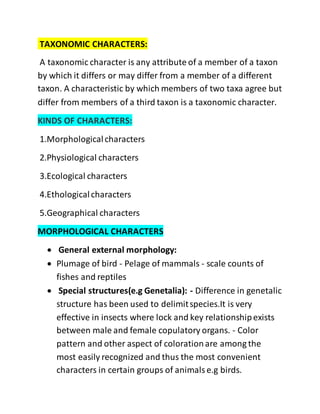
Taxonomic characters
- 1. TAXONOMIC CHARACTERS: A taxonomic character is any attribute of a member of a taxon by which it differs or may differ from a member of a different taxon. A characteristic by which members of two taxa agree but differ from members of a third taxon is a taxonomic character. KINDS OF CHARACTERS: 1.Morphologicalcharacters 2.Physiological characters 3.Ecological characters 4.Ethologicalcharacters 5.Geographical characters MORPHOLOGICAL CHARACTERS General external morphology: Plumage of bird - Pelage of mammals - scale counts of fishes and reptiles Special structures(e.g Genetalia): - Difference in genetalic structure has been used to delimitspecies.It is very effective in insects where lock and key relationshipexists between male and female copulatory organs. - Color pattern and other aspect of colorationare among the most easily recognized and thus the most convenient characters in certain groups of animalse.g birds.
- 2. Internal morphology: - Both the soft as well as hard parts of practically all groups of higher animalshave been used as taxonomic characters. d.Larval stages and embryology: - Variousimmature or larval stages,the embryology and sometimes even the eggs may provide taxonomic information.e.g the various siblingspecies of the Anopheles maculipeniscomplex were discovered owing to differences in egg structure. - The classificationof white flies is based primarily on the pupae. - Comparative studies of embryological characters like cleavage pattern,blastulation,gastrulationare also useful in certain phyla. Karyology: karyology is the description of chromosome structure,size,shape and number etc. Chromosomes are particularlyuseful on two different levels - On the one hand ,they aid in the comparison of closely related species,includingsibling species.These are often far more different chromosomally than in their external morphology. - on the other hand,chromosomalpatterns are of extreme importance in establishingphyletic lines. PHYSIOLOGICAL CHARACTERS This group of character is hard to define. All structures are the products of physiologicalprocesses and are thus physiological characters. By physiologicalcharacters one generally means
- 3. growth constants,temperature tolerances and the various processes studied by comparative physiologist. These characters cannot be studied in preserved material. Serology:The proteins of one organism will react more strongly with antibodiesto the proteinsof a closely related organism than to those of one more distantly related. Sibley analysedthe egg-white proteinsof more than 100 species of birds and was able to establish relationshipamong them. ECOLOGICAL CHARACTERS Every species has its own niche in nature,differing from its nearest relatives in food prefrence,breeding season,tolerance to variousphysical factors,resistance to predators,competitors and pathogensand in other ecologicalfactors. E.g the larvae of both Drosophilamulleri and aldriachilive simultaneouslyin the decayingpulp of the fruits of the cactus Opuntia lindheimeri.The two species are markedly specialized in their preference for certain yeast and bacteria. Similarlytapeworms of man and rodents and ascaris of man and pigs though differ very slightly but can be identifiedby their host specificity. Each genus of galapagos finches is characterized by its utilizationof the environment,Geospizais a ground finch while Camarhynchusis a tree finch.
- 4. ETHOLOGICAL CHARACTERS: Behaviouris one of the most important soures of taxonomic characters. They are clearly superior to morphologicalcharacters in the study of closely related species. Similarly bioacousticslike matting calls of frogs and toads and crickets are used for species delimitation.Similarlythe pattern of the webbing constructed by spiders can be used at variouslevel in classification. GEOGRAPHICAL CHARACTERS: Geographicalcharacters are among the most useful tools for clarifying a confused taxonomic picture and for testing taxonomic hypothesis. The taxonomist is primarily interested in two kinds of geographicalcharacters. (1)general biogeographicpatterns ,which are especiallyuseful in the arrangement of higher taxa. (2) the allopatric-sympatricrelationship,which ismost helpfulin determining whether or not two populationsare conspecific.